.
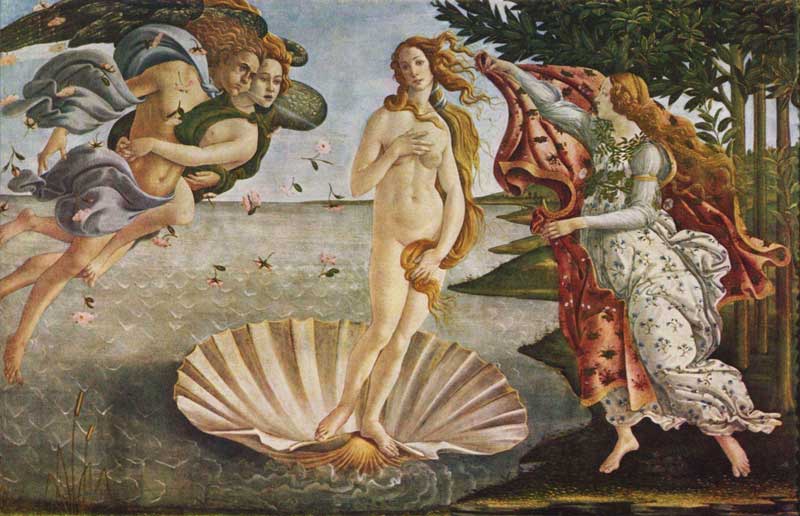
Botticelli , The Birth of Venus
Buy Fine Art Prints | Greeting Cards | iPhone Cases
The Birth of Venus is a painting by Sandro Botticelli. It depicts the Goddess Venus, having emerged from the sea as a full grown woman, arriving at the sea-shore.
This large picture by Botticelli may have been, like the Primavera, painted for Lorenzo di Pierfrancesco's Villa di Castello, around 1483, or even before. Some scholars suggest that the Venus painted for Lorenzo and mentioned by Giorgio Vasari may have been a different, now lost, work to the painting in the Uffizi. Some experts believe it to be a celebration of the love of Giuliano di Piero de' Medici (who died in the Pazzi conspiracy in 1478) for Simonetta Cattaneo Vespucci, who lived in Portovenere, a town by the sea with a local tradition of being the birthplace of Venus. Whatever inspired the artist, there are clear similarities to Ovid's Metamorphoses and Fasti, as well as to Poliziano's Verses.
The classical Goddess Venus emerges from the water on a shell, blown towards shore by the Zephyrs, symbols of spiritual passions, and with one of the Ores, goddesses of the seasons, who hands her a flowered cloak. According to some commentators, the naked goddess isn't then a symbol of earthly but of spiritual love, like an ancient marble statue (which might have inspired the 18th century sculptor, Antonio Canova, by its candor), slim and long-limbed, with harmonious features.
The effect, nonetheless, is distinctly pagan considering it was made at a time and place when most artworks depicted Roman Catholic themes. It is somewhat surprising that this canvas escaped the flames of Savonarola's bonfires, where a number of Botticelli's other "pagan" influenced works perished.

Detail of Venus
The anatomy of Venus and various subsidiary details do not display the strict classical realism of Leonardo da Vinci or Raphael. Most obviously, Venus has an improbably long neck, and her left shoulder slopes at an anatomically unlikely angle. Such details, whether artistic errors or artistic licence, do little to diminish the great beauty of the painting, and some have suggested it prefigures mannerism.
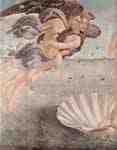

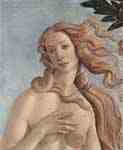
Classical inspiration
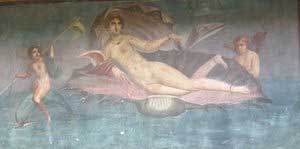
Mural at Pompeii
The painting was one of a series which Botticelli was inspired to paint after written descriptions by the 2nd century historian Lucian of masterpieces of Ancient Greece which had long since disappeared by Botticelli's time. The ancient painting by Apelles was called Anadyomene Venus, "Anadyomene" meaning "rising from the sea"; this title was also used for Botticelli's painting, The Birth of Venus only becoming its better known title in the 19th century.
A mural from Pompeii was never seen by Botticelli, but may have been a Roman copy of the then famous painting by Apelles which Lucian mentioned.
In classical antiquity, the sea shell was a metaphor for a woman's vulva.
The pose of Botticelli's Venus is reminiscent of the Venus de Medici, a marble sculpture from classical antiquity in the Medici collection which Botticelli had opportunity to study.
Botticelli's "Birth of Venus" in literature
A subplot (chapter 7) of Thomas Pynchon's novel V. (1961) centers on an attempt to steal the painting from the Uffizi gallery in Florence. Rafael Mantissa, an exile from Venezuela, is more or less in love with Venus. While some correctly argue that this is not your regular motive for stealing a painting, this is an underscored point of the novel: the paradoxical relation of men to Woman. Men are attracted to Woman, but at the same time destroyed. However, all of this is perceived by one of the characters, Herbert Stencil, in his attempt to come to terms with loss through historical imagination and historiography - the famous 'historical chapters' in V..
Botticelli's "Birth of Venus" in popular culture
- Reproductions and variations on Botticelli's famous painting have been numerous in popular culture, including in advertising and motion pictures:
- A scene in the 1962 James Bond film Dr. No with Ursula Andress rising from the sea was inspired by the painting. The scene was recreated in more detail in the 1988 film The Adventures of Baron Munchausen, with Uma Thurman as Venus.
- Munchausen's director Terry Gilliam had previously featured the painting in an animated sequence in Monty Python's Flying Circus, segueing into the Dead Parrot sketch.
- Adobe Illustrator used a stylized representation of the painting in its splash screen through version 10.
- A stylized face of Venus is on the 10 cent Italian euro coins.
- On the Simpsons episode The Last Temptation of Homer, Homer hallucinates The Birth of Venus upon first meeting his new female co-worker.
- In the episode The Secret Snake Club in The Grim Adventures of Billy and Mandy, Irwin makes a painting that has Mandy's head as a replacement of Venus's head.
- The "Kilgore Trout" novel Venus on the Half-Shell is titled from a jocular nickname for the painting.

- In the 2006 Winter Olympics Opening Ceremony, Eva Herzigová appears as Venus from a shell.
- From Joni Mitchell's 1991 album "Night Ride Home." In the song "The Only Joy In Town," the opening lyrics are, "I want to paint a picture Botticelli style, Instead of Venus on a clam I'd paint this flower child"
- In the game Animal Crossing, a painting of Venus can be obtained as an item.
WALTER PATER
In Leonardo's treatise on painting only one contemporary is mentioned by name—Sandro Botticelli. This pre-eminence may be due to chance only, but to some will rather appear a result of deliberate judgment; for people have begun to find out the charm of Botticelli's work, and his name, little known in the last century, is quietly becoming important. In the middle of the Fifteenth Century he had already anticipated much of that meditative subtlety which is sometimes supposed peculiar to the great imaginative workmen of its close. Leaving the simple religion which had occupied the followers of Giotto for a century, and the simple naturalism which had grown out of it, a thing of birds and flowers only, he sought inspiration in what to him were works of the modern world, the writings of Dante and Boccaccio, and in new readings of his own of classical stories; or if he painted religious subjects, painted them with an undercurrent of original sentiment which touches you as the real matter of the picture through the veil of its ostensible subject. What is the peculiar sensation, what is the peculiar quality of pleasure which his work has the property of exciting in us, and which we cannot get elsewhere? For this, especially when he has to speak of a comparatively unknown artist, is always the chief question which a critic has to answer.
In an age when the lives of artists were full of adventure, his life is almost colourless. Criticism indeed has cleared away much of the gossip which Vasari accumulated, has touched the legend of Lippo and Lucrezia, and rehabilitated the character of Andrea del Castagno; but in Botticelli's case there is no legend to dissipate. He did not even go by his true name: Sandro is a nickname, and his true name is Filipepi, Botticelli being only the name of the goldsmith who first taught him art. Only two things happened to him, two things which he shared with other artists—he was invited to Rome to paint in the Sistine Chapel, and he fell in later life under the influence of Savonarola, passing apparently almost out of men's sight in a sort of religious melancholy which lasted till his death in 1515, according to the received date. Vasari says that he plunged into the study of Dante, and even wrote a comment on the Divine Comedy. But it seems strange that he should have lived on inactive so long; and one almost wishes that some document might come to light which, fixing the date of his death earlier, might relieve one, in thinking of him, of his dejected old age.
The Birth of Venus.
Botticelli.
He is before all things a poetical painter, blending the charm of story and sentiment, the medium of the art of poetry, with the charm of line and colour, the medium of abstract painting. So he becomes the illustrator of Dante. In a few rare examples of the edition of 1481, the blank spaces left at the beginning of every canto for the hand of the illuminator have been filled as far as the nineteenth canto of the Inferno, with impressions of engraved plates, seemingly by way of experiment, for in the copy in the Bodleian Library, one of the three impressions it contains has been printed upside down and much awry in the midst of the luxurious printed page. Giotto, and the followers of Giotto, with their almost childish religious aim, had not learned to put that weight of meaning into outward things, light, colour, every-day gesture, which the poetry of the Divine Comedy involves, and before the Fifteenth Century Dante could hardly have found an illustrator. Botticelli's illustrations are crowded with incident, blending with a naïve carelessness of pictorial propriety three phases of the same scene into one plate. The grotesques, so often a stumbling-block to painters who forget that the words of a poet, which only feebly present an image to the mind, must be lowered in key when translated into form, make one regret that he has not rather chosen for illustration the more subdued imagery of the Purgatorio. Yet in the scene of those who go down quick into hell there is an invention about the fire taking hold on the up-turned soles of the feet, which proves that the design is no mere translation of Dante's words, but a true painter's vision; while the scene of the Centaurs wins one at once, for, forgetful of the actual circumstances of their appearance, Botticelli has gone off with delight on the thought of the Centaurs themselves, bright small creatures of the woodland, with arch baby faces and mignon forms, drawing tiny bows.
Botticelli lived in a generation of naturalists, and he8 might have been a mere naturalist among them. There are traces enough in his work of that alert sense of outward things which, in the pictures of that period, fills the lawns with delicate living creatures, and the hill-sides with pools of water, and the pools of water with flowering reeds. But this was not enough for him; he is a visionary painter, and in his visionariness he resembles Dante. Giotto, the tried companion of Dante, Masaccio, Ghirlandaio even, do but transcribe with more or less refining the outward image; they are dramatic, not visionary painters; they are almost impassive spectators of the action before them. But the genius of which Botticelli is the type usurps the data before it as the exponents of ideas, moods, visions of its own; with this interest it plays fast and loose with those data, rejecting some and isolating others, and always combining them anew. To him, as to Dante, the scene, the colour, the outward image or gesture, comes with all its incisive and importunate reality; but awakes in him, moreover, by some subtle structure of his own, a mood which it awakes in no one else, of which it is the double or repetition, and which it clothes, that all may share it, with sensuous circumstances.
But he is far enough from accepting the conventional orthodoxy of Dante which, referring all human action to the easy formula of purgatory, heaven, and hell, leaves an insoluble element of prose in the depths of Dante's poetry. One picture of his, with the portrait of the donor, Matteo Palmieri, below, had the credit or discredit of attracting some shadow of ecclesiastical censure. This Matteo Palmieri—two dim figures move under that name in contemporary history—was the reputed author of a poem, still unedited, La Città Divina, which represented the human race as an incarnation of those angels who, in the revolt of Lucifer, were neither for God nor for his enemies, a fantasy of that earlier Alexandrian philosophy, about which the Florentine intellect in that century was so curious. Botticelli's picture may have been only one of those familiar compositions in which religious reverie has recorded its impressions of the various forms of beatified existence—Glorias, as they were called, like that in which Giotto painted the portrait of Dante; but somehow it was suspected of embodying in a picture the wayward dream of Palmieri, and the chapel where it hung was closed. Artists so entire as Botticelli are usually careless about philosophical theories, even when the philosopher is a Florentine of the Fifteenth Century, and his work a poem in terza rima. But Botticelli, who wrote a commentary on Dante and became the disciple of Savonarola, may well have let such theories come and go across him. True or false, the story interprets much of the peculiar sentiment with which he infuses his profane and sacred persons, comely, and in a certain sense like angels, but with a sense of displacement or loss about them—the wistfulness of exiles conscious of a passion and energy greater than any known issue of them explains, which runs through all his varied work with a sentiment of ineffable melancholy.
So just what Dante scorns as unworthy alike of heaven and hell, Botticelli accepts, that middle world in which men take no side in great conflicts, and decide no great causes, and make great refusals. He thus sets for himself the limits within which art, undisturbed by any moral ambition, does its most sincere and surest work. His interest is neither in the untempered goodness of Angelico's saints, nor the untempered evil of Orcagna's Inferno; but with men and women in their mixed and uncertain condition, always attractive, clothed sometimes by passion with a character of loveliness and energy, but saddened perpetually by the shadow upon them of the great things from which they shrink. His morality is all sympathy; and it is this sympathy, conveying into his work somewhat more than is usual of the true complexion of humanity, which makes him, visionary as he is, so forcible a realist.
It is this which gives to his Madonnas their unique expression and charm. He has worked out in them a distinct and peculiar type, definite enough in his own mind, for he has painted it over and over again, sometimes one might think almost mechanically, as a pastime during that dark period when his thoughts were so heavy upon him. Hardly any collection of note is without one of these circular pictures, into which the attendant angels depress their heads so naïvely. Perhaps you have sometimes wondered why those peevish-looking Madonnas, conformed to no acknowledged or obvious type of beauty, attract you more and more, and often come back to you when the Sistine Madonna and the virgins of Fra Angelico are forgotten. At first, contrasting them with those, you may have thought that there was even something in them mean or abject, for the abstract lines of the face have little nobleness and the colour is wan. For with Botticelli she too, though she holds in her hands the "Desire of all nations," is one of those who are neither for God nor for his enemies; and her choice is on her face. The white light on it is cast up hard and cheerless from below, as when snow lies upon the ground, and the children look up with surprise at the strange whiteness of the ceiling. Her trouble is in the very caress of the mysterious child, whose gaze is always far from her, and who has already that sweet look of devotion which men have never been able altogether to love, and which still makes the born saint an object almost of suspicion to his earthly brethren. Once, indeed, he guides her hand to transcribe in a book the words of her exaltation, the Ave and the Magnificat, and the Gaude Maria, and the young angels, glad to rouse her for a moment from her dejection, are eager to hold the inkhorn and support the book; but the pen almost drops from her hand, and the high cold words have no meaning for her, and her true children are those others, in the midst of whom, in her rude home, the intolerable honour came to her, with that look of wistful inquiry on their irregular faces which you see in startled animals—gipsy children, such as those who, in Apennine villages, still hold out their long brown arms to beg of you, but on Sundays become enfants du chœur with their thick black hair nicely combed and fair white linen on their sunburnt throats.
What is strangest is that he carries this sentiment into classical subjects, its most complete expression being a picture in the Uffizi, of Venus rising from the sea, in which the grotesque emblems of the middle age, and a landscape full of its peculiar feeling, and even its strange draperies powdered all over in the Gothic manner with a quaint conceit of daisies, frame a figure that reminds you of the faultless nude studies of Ingres. At first, perhaps, you are attracted only by a quaintness of design, which seems to recall all at once whatever you have read of Florence in the Fifteenth Century; afterwards you may think that this quaintness must be incongruous with the subject, and that the colour is cadaverous, or at least cold. And yet the more you come to understand what imaginative colouring really is, that all colour is no mere delightful quality of natural things, but a spirit upon them by which they become expressive to the spirit, the better you will like this peculiar quality of colour; and you will find that quaint design of Botticelli's a more direct inlet into the Greek temper than the works of the Greeks themselves even of the finest period. Of the Greeks as they really were, of their difference from ourselves, of the aspects of their outward life, we know far more than Botticelli, or his most learned contemporaries; but for us, long familiarity has taken off the edge of the lesson, and we are hardly conscious of what we owe to the Hellenic spirit. But in pictures like this of Botticelli's you have a record of the first impression made by it on minds turned back towards it in almost painful aspiration from a world in which it had been ignored so long; and in the passion, the energy, the industry of realization, with which Botticelli carries out his intention, is the exact measure of the legitimate influence over the human mind of the imaginative system of which this is the central myth. The light is, indeed, cold—mere sunless dawn; but a later painter would have cloyed you with sunshine; and you can see the better for that quietness in the morning air each long promontory as it slopes down to the water's edge. Men go forth to their labours until the evening; but she is awake before them, and you might think that the sorrow in her face was at the thought of the whole long day of love yet to come. An emblematical figure of the wind blows hard across the grey water, moving forward the dainty-lipped shell on which she sails, the sea "showing his teeth" as it moves in thin lines of foam, and sucking in one by one the falling roses, each severe in outline, plucked off short at the stalk, but embrowned a little, as Botticelli's flowers always are. Botticelli meant all that imagery to be altogether pleasurable; and it was partly an incompleteness of resources, inseparable from the art of that time, that subdued and chilled it; but his predilection for minor tones counts also; and what is unmistakable is the sadness with which he has conceived the goddess of pleasure as the depository of a great power over the lives of men.
I have said that the peculiar character of Botticelli is the result of a blending in him of a sympathy for humanity in its uncertain condition, its attractiveness, its investiture at rarer moments in a character of loveliness and energy, with his consciousness of the shadow upon it of the great things from which it shrinks, and that this conveys into his work somewhat more than painting usually attains of the true complexion of humanity. He paints the story of the goddess of pleasure in other episodes besides that of her birth from the sea, but never without some shadow of death in the grey flesh and wan flowers. He paints Madonnas, but they shrink from the pressure of the divine child, and plead in unmistakable undertones for a warmer, lower humanity. The same figure—tradition connects it with Simonetta, the mistress of Giuliano de' Medici—appears again as Judith returning home across the hill country when the great deed is over, and the moment of revulsion come, and the olive branch in her hand is becoming a burthen; as Justice, sitting on a throne, but with a fixed look of self-hatred which makes the sword in her hand seem that of a suicide; and again as Veritas in the allegorical picture of Calumnia, where one may note in passing the suggestiveness of an accident which identifies the image of Truth with the person of Venus. We might trace the same sentiment through his engravings; but his share in them is doubtful, and the object of this fragment has been attained if I have defined aright the temper in which he worked.
But, after all, it may be asked, is a painter like Botticelli, a second-rate painter, a proper subject for general criticism? There are a few great painters, like Michael Angelo or Leonardo, whose work has become a force in general culture, partly for this very reason that they have absorbed into themselves all such workmen as Sandro Botticelli; and, over and above mere technical or antiquarian criticism, general criticism may be very well employed in that sort of interpretation which adjusts the position of these men to general culture, whereas smaller men can be the proper subjects only of technical or antiquarian treatment. But, besides those great men, there is a certain number of artists who have a distinct faculty of their own by which they convey to us a peculiar quality of pleasure which we cannot get elsewhere, and these, too, have their place in general culture, and have to be interpreted to it by those who have felt their charm strongly, and are often the objects of a special diligence and a consideration wholly affectionate, just because there is not about them the stress of a great name and authority. Of this select number Botticelli is one; he has the freshness, the uncertain and diffident promise which belongs to the earlier Renaissance itself, and makes it perhaps the most interesting period in the history of the mind; in studying his work one begins to understand to how great a place in human culture the art of Italy had been called.
Studies in the History of the Renaissance (London, 1873).
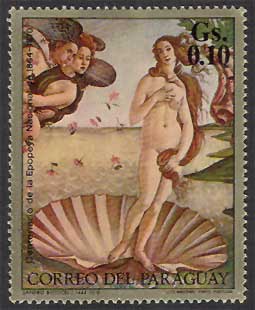
The Birth of Venus, Botticelli, Stamp
----
Fine Art Prints | Greeting Cards | Phone Cases | Lifestyle | Face Masks | Men's , Women' Apparel | Home Decor | jigsaw puzzles | Notebooks | Tapestries | ...
----
| Ancient Greece
Science, Technology , Medicine , Warfare, , Biographies , Life , Cities/Places/Maps , Arts , Literature , Philosophy ,Olympics, Mythology , History , Images Medieval Greece / Byzantine Empire Science, Technology, Arts, , Warfare , Literature, Biographies, Icons, History Modern Greece Cities, Islands, Regions, Fauna/Flora ,Biographies , History , Warfare, Science/Technology, Literature, Music , Arts , Film/Actors , Sport , Fashion --- |


